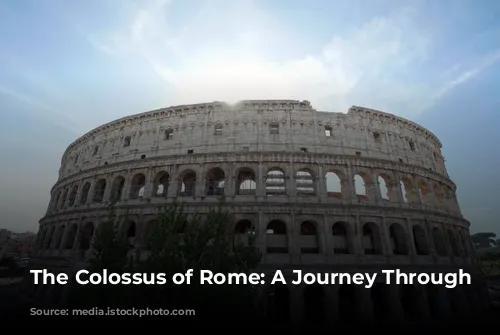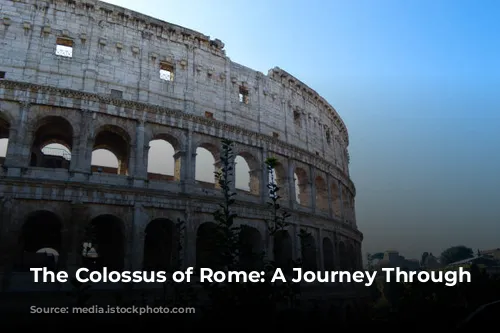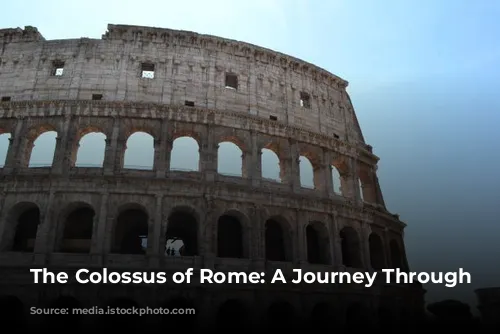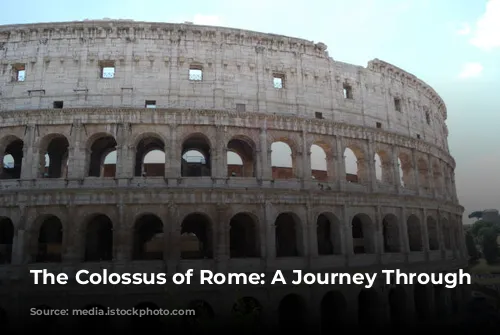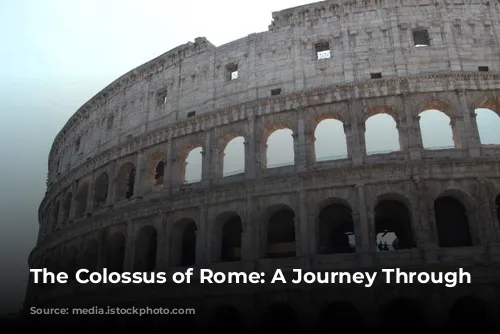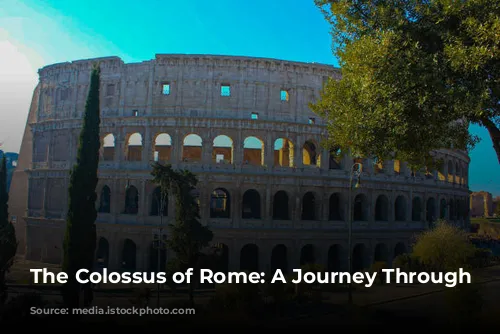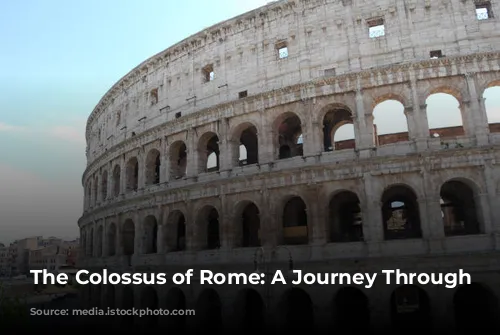The Colosseum, a name synonymous with ancient Rome, stands as a testament to the grandeur and ingenuity of the Roman Empire. This majestic amphitheater, the largest and most impressive in the Roman world, was originally known as the Flavian Amphitheatre, named after the Flavian dynasty that commissioned its construction. Emperor Vespasian initiated the project, and his son, Titus, inaugurated it in 80 AD with a spectacular 100-day opening ceremony.
The festivities were a testament to the Romans’ love for spectacle and grandeur, featuring epic gladiatorial combats, breathtaking animal hunts, and naumachiae – simulated naval battles that transformed the arena into a vast watery stage. Imagine thousands of animals, including 5000 alone during the grand opening, facing their demise in a sea of blood and spectacle.
The Colosseum’s Name: A Tale of Prophecy and a Lost Colossus
But why is this architectural marvel known as the Colosseum? This name first appears in a prophetic inscription by Venerable Bede, a medieval monk, who declared, “Rome will exist as long as the Colosseum does; when the Colosseum falls so will Rome; when Rome falls so will the world”. Perhaps he drew inspiration from the enormous statue of Emperor Nero, known as “the Colossus”, that stood 35 meters tall and was tragically destroyed. This statue stood proudly beside the amphitheater, lending its name to the structure that would eclipse it in fame.
A Triumph of Roman Engineering: The Power of the Arch
The Colosseum stands as a testament to the Romans’ architectural genius. This imposing elliptical structure was built in less than a decade, showcasing the efficiency and skill of Roman builders. Its towering height is a marvel of engineering, with four floors and eighty arches adorning the first three levels. The second and third floors were further embellished with grand statues, adding to the Colosseum’s awe-inspiring presence.
The Romans’ mastery of the arch played a crucial role in the Colosseum’s construction. This ingenious architectural element allowed them to distribute the weight of massive structures effectively, as seen in their iconic aqueducts. The Colosseum, in essence, can be seen as a series of aqueducts stacked upon one another, demonstrating the Romans’ mastery of structural integrity and innovative design.
A Glimpse into the Colosseum’s Past: Echoes of Glory and Decay
Today, we see only a skeleton of the Colosseum’s former glory, with three-fifths of its outer brick wall missing. This decline began during the Middle Ages, when the Colosseum was repurposed as a source of valuable materials. Popes, seeking materials for their grand projects, transformed the Colosseum into a quarry of marble, lead, and iron.
The holes visible on the Colosseum’s columns are a testament to this period of plunder. They were created to extract lead and iron, valuable materials used by the Romans for the nails embedded in the marble blocks. These scars of time tell a story of how even the mightiest structures are subject to the ravages of time and human greed.
A Seating Arrangement Reflecting Roman Society
The Colosseum, once a stage for epic displays of power and spectacle, could accommodate up to 70,000 spectators. The tiers of seats were strategically designed to offer unobstructed views from every vantage point.
Entry to the Colosseum was free for Roman citizens, but social hierarchy dictated seating arrangements. The top tiers were reserved for the commoners, with separate sections for men and women. As you moved closer to the arena, the social status of the spectators increased. The front row was the domain of the elite, including senators, vestals, priests, and, of course, the emperor.
Sun Protection and Spectacle: The Colosseum’s Ingenious Roof
Like modern stadiums, the Colosseum provided its spectators with protection from the sun through an ingenious system called the Velarium. This enormous linen canopy, suspended by a network of ropes, winches, and wooden poles, was stretched across the amphitheater’s upper walls. One hundred sailors from the Imperial fleet were responsible for manipulating this massive structure, moving it in perfect synchrony to the beat of a drum.
The Gladiators: Warriors, Slaves, and Entertainers
The arena itself was a stage for gladiatorial combats, where the fate of men hung in the balance. The cellars beneath the arena housed the intricate mechanisms that brought the spectacle to life, including lifts and hoists for bringing animals and gladiators into the arena with dramatic surprise. These special effects, hidden from view, were a testament to the Romans’ ingenuity in staging the ultimate entertainment.
The gladiators, warriors who fought for freedom, fame, and fortune, were a diverse group. They included captives of war, prisoners given the choice of servitude or fighting, and paupers seeking a path to riches.
These warriors, often celebrated as heroes by the public, trained in the Ludus Magnus, a gladiatorial school. They entered the arena through a passageway leading directly from their barracks, welcomed by the cheers of their fans. Their entrance was a theatrical spectacle, culminating in a salute to the emperor with the iconic phrase, “Ave Caesar, morituri te salutant” (Hail Caesar, those who are about to die salute you).
The Gladiatorial Games: A Deadly Dance of Skill and Spectacle
There were twelve distinct types of gladiators, each with their unique weaponry and fighting styles. Retiarii armed with nets and tridents clashed with Secutores wielding shields and sickles. The confrontations were orchestrated for dramatic effect, captivating the audience with a thrilling blend of skill and brutality.
The fate of the vanquished gladiator rested in the hands of the emperor, who would decree life or death based on the audience’s wishes. A thumbs up meant mercy, a thumbs down signified execution. The winners received golden palm leaves and lavish rewards.
A Bloodthirsty Spectacle: Roman Entertainment and the Colosseum
The Colosseum was not just a stage for gladiatorial combat. It hosted a variety of spectacles, ranging from animal hunts to executions and even unique performances, like an elephant that could write words with its trunk. While the Colosseum was not used to kill Christians as a form of spectacle, the audience’s appetite for blood and brutality cannot be denied.
The Romans’ passion for violence and spectacle can be compared to modern-day fascination with “splatter cinema,” but with one crucial difference: the stark reality of the violence. The Colosseum was a place where the smell of blood, burnt flesh, and wild animals permeated the air, creating a sensory experience that was both terrifying and captivating.
From Glory to Ruins: The Colosseum’s Legacy
After the fall of the Roman Empire, the Colosseum fell into disuse, its walls providing shelter to confraternities, hospitals, hermits, and even a cemetery. It eventually became a quarry for building materials, its majestic stones used for projects like Barberini Palace, Piazza Venezia, and even St. Peter’s Basilica.
Despite its decline, the Colosseum remained a symbol of Rome’s grandeur. It was rescued from demolition by Pope Benedict XIV, who declared it a sacred monument dedicated to the Passion of Christ. A cross, placed on a pedestal, marks the starting point for the Stations of the Cross on Good Friday, adding a new layer of meaning to this ancient monument.
Today, the Colosseum stands as a reminder of Rome’s past glory, a testament to the power of the human spirit to create and destroy, to build and plunder. As Charles Dickens eloquently put it, “seeing the Colosseum means, seeing the ghost of old Rome floating over the places its people walk in.”
